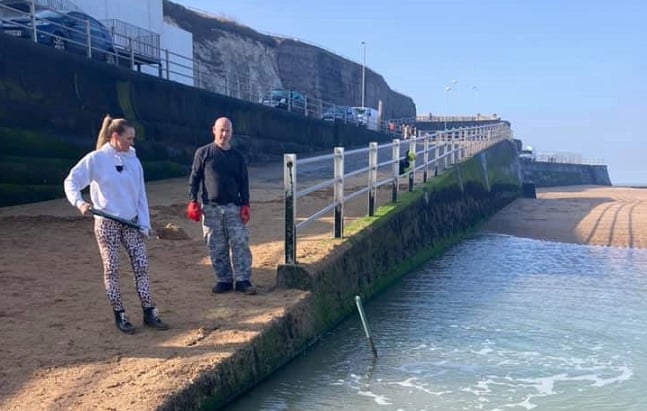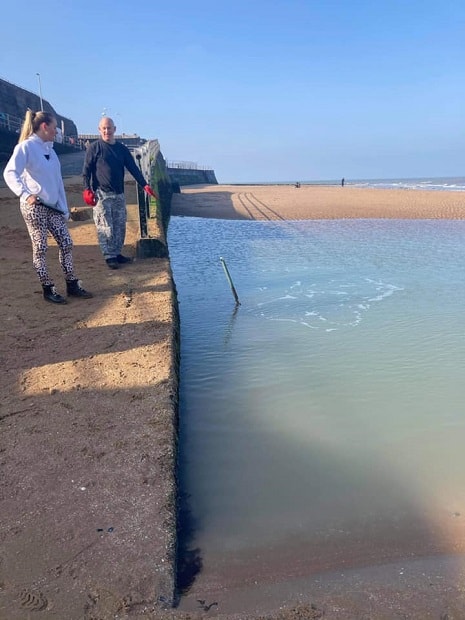
Residents have rallied to fill in a ‘hidden drop’ under a deceptively shallow-looking water area at the slipway behind the Winter Gardens in Margate.
The area has been the site of several incidents with children, adults and dogs becoming trapped because they are unaware of the depth of the drop.
It is caused by waves scouring the sand and tidal changes, which means the depth fluctuates rather than being constant.
Earlier this month resident Kerry September made a call for people power action after she pulled a toddler out of the tidal hole when the child fell in.
Also this month hairdresser Cassie Davey spoke of how her dog became submerged in the water and she then became trapped trying to rescue him.
Last year The Isle of Thanet News told how a little boy plunged under the water and had to be dragged out by his mum. Shortly after a distraught dog owner told how her rescue dog died after he went into water at the bottom of the beach slipway, but then got into trouble.
Sadly the experience proved too much for the dog and the water he had ingested resulted in kidney failure.
Although there is signage by the site, there have been calls for the hole to be filled in and/or greater safety measures to be installed.
Today (February 28) five residents – Kerry; Athelstan Road tenants’ association member Matt Shoul; Melanie Ball; Gemma Cole and Orla Morton Dollman – spent some two and a half hours shovelling sand into the pool to try and level off the drop.
The group cleared sand from the bottom of the concrete ramp and focused on filling in the deepest point of the puddle.
Matt said: “Following recent comments on social media, on the size, depth and potential danger posed by the growth of this naturally fluctuating tidal eddy pool, I suggested getting together to fill it in.
“This Sunday, five of us gathered at the bottom of the ramp and shifted around 3.6 metric tonnes of sand off the bottom of the ramp and into the deepest point of the puddle.
“After two and a half hours, we’d raised the deepest point, estimated to be between 4’-6’, to about 4” below the surface of the puddle at low tide.
“A second session is planned to finish off removing sand from the bottom of the concrete ramp and into the puddle on Sunday, March 7, around two-and-a-half hours after high tide – exact time not known just yet – but probably around 8:30am.
“Anyone with a spade is very welcome – social distancing on this breezy beach poses a minimal infection risk.”
Matt says a check on the depth of the ‘pool’ will be made in the week.

Kerry also urged people to come to the next session, saying: “It would be great if more lovely volunteers/community of Margate could come forward and give up 2 hours of their time to help us fill it further.
“There was a great camaraderie this morning. It could be your child or dog but we can prevent something serious happening.”
Earlier this month Thanet council said ways to increase prominence of safety signs was being explored.
A council spokesperson said: “This location was last reviewed by our team of Coastal Officers in June 2020 as part of their risk assessments along the Thanet coastline. New signage, which will be reviewed annually, has been added to the railings at this area to warn people of the risks.
“The team is exploring other ways to increase the prominence of signage in this particular area, as well as a review of coastal safety signage more generally. It is particularly important to ensure that anything that’s added can withstand the impact of the sea. The team is also reviewing whether other options, such as extending the railings to the bottom of the slipway, are a viable possibility.
“Due to the nature of our coastlines, hazards can present themselves without notice. We advise people to ensure they consider the risks that might be involved when walking along our beaches, particularly during the winter months when daylight hours are reduced and there are changeable temperatures. People should also always be aware of the tides and use caution when exploring the coast, both in Thanet and any part of the UK.”

